hello guys
Probabilities are not my strong suite and Here goes a question that proves me right;
Of the 20 members of a kitchen crew, 17 can use the meat-cutting machine, 18 can use the bread-slicing machine, and 15 can use both machines. If one member of the crew is to be chosen at random, what is the probability that the member chosen will be someone who cannot use either machine.
0 : 1/10 : 1/7 : 1/4 : 1/3
Does anybody have a quick easy answer?
Cheers
Lukas
kitchen crew
This topic has expert replies
-
lukaswelker
- Senior | Next Rank: 100 Posts
- Posts: 65
- Joined: Wed Mar 26, 2014 6:56 am
- Followed by:1 members
- theCodeToGMAT
- Legendary Member
- Posts: 1556
- Joined: Tue Aug 14, 2012 11:18 pm
- Thanked: 448 times
- Followed by:34 members
- GMAT Score:650
17 = use meat cutting machine
18 = bread slicing Machine
15 = both
(17-15) = 2 can use only Cutting Machine
(18-15) = 3 can use only Slicing Machine
15 can use both
S0, {0} since20 = (2) + (15) + (3)
18 = bread slicing Machine
15 = both
(17-15) = 2 can use only Cutting Machine
(18-15) = 3 can use only Slicing Machine
15 can use both
S0, {0} since20 = (2) + (15) + (3)
R A H U L
GMAT/MBA Expert
- Brent@GMATPrepNow
- GMAT Instructor
- Posts: 16207
- Joined: Mon Dec 08, 2008 6:26 pm
- Location: Vancouver, BC
- Thanked: 5254 times
- Followed by:1268 members
- GMAT Score:770
One approach is to use the Double Matrix Method. This technique can be used for most questions featuring a population in which each member has two characteristics associated with it.lukaswelker wrote:
Of the 20 members of a kitchen crew, 17 can use the meat-cutting machine, 18 can use the bread-slicing machine, and 15 can use both machines. If one member of the crew is to be chosen at random, what is the probability that the member chosen will be someone who cannot use either machine.
A) 0
B) 1/10
C) 1/7
D) 1/4
E) 1/3
Here, we have a population of kitchen staff, and the two characteristics are:
- can use the meat-cutting machine or cannot use the meat-cutting machine
- can use the bread-slicing machine or cannot use the bread-slicing machine
There are 20 people altogether, so we can set up our diagram as follows:
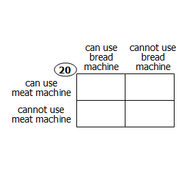
Given: 17 can use the meat-cutting machine
This means that 3 cannot use the meat-cutting machine
We'll add this to our diagram:
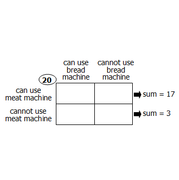
Given: 18 can use the bread-slicing machine
This means that 2 cannot use the bread-slicing machine
We'll add this to our diagram:
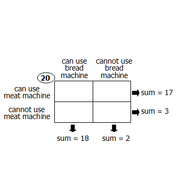
Given: 15 can use both machines
We'll add this to our diagram:
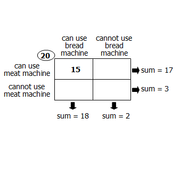
Since we know the SUMS of the boxes in each column and in each row, we can complete the diagram as follows:
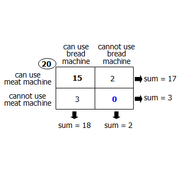
As we can see, there are 0 people in the box representing someone who cannot use either machine.
So, P( selected person cannot use either machine) = [spoiler]0/20 = 0 = A[/spoiler]
--------------------------
To learn more about the Double Matrix Method, watch our free video: https://www.gmatprepnow.com/module/gmat- ... ems?id=919
Once you're familiar with this technique, you can attempt these additional practice questions:
Easy Problem Solving questions
- https://www.beatthegmat.com/the-aam-aadm ... 72242.html
- https://www.beatthegmat.com/finance-majo ... 67425.html
Medium Problem Solving questions
- https://www.beatthegmat.com/probability- ... 73360.html
- https://www.beatthegmat.com/posted-speed ... 72374.html
- https://www.beatthegmat.com/motel-t271938.html
- https://www.beatthegmat.com/of-the-appli ... 70255.html
- https://www.beatthegmat.com/opening-nigh ... 64869.html
- https://www.beatthegmat.com/ds-french-ja ... 22297.html
Difficult Problem Solving questions
- https://www.beatthegmat.com/ratio-problem-t268339.html
- https://www.beatthegmat.com/overlapping- ... 65223.html
- https://www.beatthegmat.com/fractions-t264254.html
- https://www.beatthegmat.com/overlapping- ... 64092.html
- https://www.beatthegmat.com/mba/2011/05/ ... question-2
Easy Data Sufficiency questions
- https://www.beatthegmat.com/for-what-per ... 70596.html
- https://www.beatthegmat.com/ds-quest-t187706.html
Medium Data Sufficiency questions
- https://www.beatthegmat.com/sets-matrix-ds-t271914.html
- https://www.beatthegmat.com/each-of-peop ... 71375.html
- https://www.beatthegmat.com/a-manufacturer-t270331.html
- https://www.beatthegmat.com/in-costume-f ... 69355.html
- https://www.beatthegmat.com/mba/2011/05/ ... question-1
Difficult Data Sufficiency questions
- https://www.beatthegmat.com/double-set-m ... 71423.html
- https://www.beatthegmat.com/sets-t269449.html
- https://www.beatthegmat.com/mba/2011/05/ ... question-3
Cheers,
Brent
GMAT/MBA Expert
- [email protected]
- Elite Legendary Member
- Posts: 10392
- Joined: Sun Jun 23, 2013 6:38 pm
- Location: Palo Alto, CA
- Thanked: 2867 times
- Followed by:511 members
- GMAT Score:800
Hi lukaswelker,
This question is actually an overlapping sets question. It can be solved in a couple of different ways. In addition to the tic-tac-toe board that Brent describes, you can also use an algebra equation:
Total = Group1 + Group2 - Both + Neither
Here, the...
Total = 20 members
Group 1 = meat-cutters = 17
Group 2 = bread-slicers = 18
Both = 15
20 = 17 + 18 - 15 + (people who use neither)
20 = 20 + Neither
Neither = 0
The probability of selecting someone who cannot use either machine is 0/20 = 0
Final Answer: A
As an aside, it would be unlikely for the GMAT to include a group of people with 0 members in it, so this question is not quite test-like.
GMAT assassins aren't born, they're made,
Rich
This question is actually an overlapping sets question. It can be solved in a couple of different ways. In addition to the tic-tac-toe board that Brent describes, you can also use an algebra equation:
Total = Group1 + Group2 - Both + Neither
Here, the...
Total = 20 members
Group 1 = meat-cutters = 17
Group 2 = bread-slicers = 18
Both = 15
20 = 17 + 18 - 15 + (people who use neither)
20 = 20 + Neither
Neither = 0
The probability of selecting someone who cannot use either machine is 0/20 = 0
Final Answer: A
As an aside, it would be unlikely for the GMAT to include a group of people with 0 members in it, so this question is not quite test-like.
GMAT assassins aren't born, they're made,
Rich





















